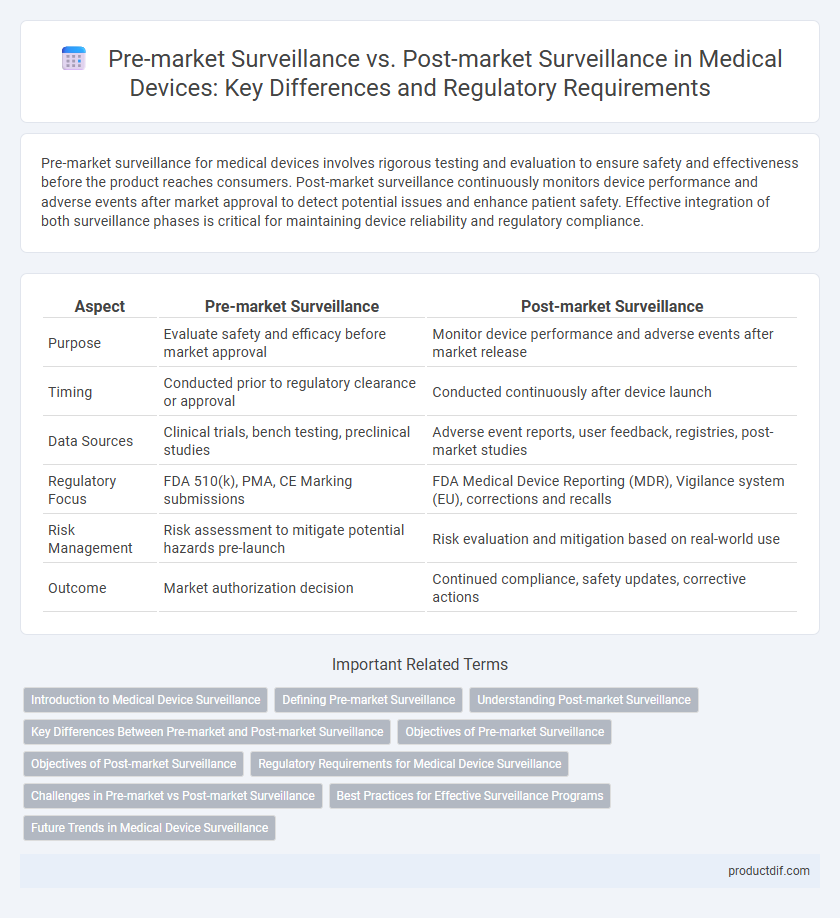Pre-market surveillance for medical devices involves rigorous testing and evaluation to ensure safety and effectiveness before the product reaches consumers. Post-market surveillance continuously monitors device performance and adverse events after market approval to detect potential issues and enhance patient safety. Effective integration of both surveillance phases is critical for maintaining device reliability and regulatory compliance.
Table of Comparison
| Aspect | Pre-market Surveillance | Post-market Surveillance |
|---|---|---|
| Purpose | Evaluate safety and efficacy before market approval | Monitor device performance and adverse events after market release |
| Timing | Conducted prior to regulatory clearance or approval | Conducted continuously after device launch |
| Data Sources | Clinical trials, bench testing, preclinical studies | Adverse event reports, user feedback, registries, post-market studies |
| Regulatory Focus | FDA 510(k), PMA, CE Marking submissions | FDA Medical Device Reporting (MDR), Vigilance system (EU), corrections and recalls |
| Risk Management | Risk assessment to mitigate potential hazards pre-launch | Risk evaluation and mitigation based on real-world use |
| Outcome | Market authorization decision | Continued compliance, safety updates, corrective actions |
Introduction to Medical Device Surveillance
Medical device surveillance encompasses both pre-market and post-market activities critical for ensuring device safety and effectiveness. Pre-market surveillance focuses on evaluating product design, performance, and compliance with regulatory standards before market entry. Post-market surveillance continuously monitors devices in real-world use to detect adverse events, assess long-term risks, and inform necessary corrective actions.
Defining Pre-market Surveillance
Pre-market surveillance in the medical device industry involves systematic evaluation and monitoring of device safety, performance, and compliance before market authorization. It includes rigorous testing, clinical trials, and risk assessments to ensure devices meet regulatory standards set by authorities like the FDA or EMA. This proactive approach aims to identify potential hazards and validate device efficacy, minimizing risks to patients prior to commercial release.
Understanding Post-market Surveillance
Post-market surveillance involves continuous monitoring of medical devices after they have been released to the market, ensuring ongoing safety and effectiveness through real-world data collection and analysis. Key activities include tracking adverse events, device performance, and user feedback to identify potential risks and implement corrective actions promptly. This process complements pre-market surveillance, which focuses on initial safety and efficacy evaluations before device approval.
Key Differences Between Pre-market and Post-market Surveillance
Pre-market surveillance involves the systematic evaluation of a medical device's safety, performance, and compliance before it reaches the market, including clinical trials and risk assessments. Post-market surveillance focuses on monitoring the device after commercialization, collecting real-world data on adverse events, device failures, and user feedback to ensure continued safety and effectiveness. Key differences lie in timing, data sources, and objectives, with pre-market surveillance emphasizing predictive risk mitigation, while post-market surveillances target ongoing risk management and regulatory compliance.
Objectives of Pre-market Surveillance
Pre-market surveillance aims to evaluate the safety, efficacy, and performance of medical devices before they reach the market, ensuring regulatory compliance and risk mitigation. It involves rigorous testing, clinical trials, and validation processes to identify potential design flaws or adverse effects early. This proactive monitoring helps manufacturers optimize product quality and protect patient health prior to commercial release.
Objectives of Post-market Surveillance
Post-market surveillance aims to continuously monitor the safety, performance, and effectiveness of medical devices after they have been released to the market. It involves collecting real-world data on device usage, adverse events, and long-term outcomes to identify potential risks and implement corrective actions promptly. Ensuring compliance with regulatory requirements and maintaining patient safety through ongoing device evaluation are key objectives of post-market surveillance.
Regulatory Requirements for Medical Device Surveillance
Pre-market surveillance for medical devices involves regulatory requirements such as clinical evaluations, performance testing, and risk assessments mandated by authorities like the FDA and the EU MDR to ensure device safety and efficacy before market entry. Post-market surveillance focuses on continuous monitoring through adverse event reporting, periodic safety update reports (PSURs), and real-world data collection to detect potential issues after the device is commercially available. Compliance with regulatory frameworks like ISO 13485 and guidance from bodies such as the MHRA ensures robust surveillance throughout the product lifecycle.
Challenges in Pre-market vs Post-market Surveillance
Pre-market surveillance faces challenges such as limited real-world data, small sample sizes, and predictive uncertainty regarding device performance under diverse clinical conditions. Post-market surveillance struggles with inconsistent reporting, data fragmentation, and delays in identifying adverse events, which hinder timely risk mitigation. Both phases require robust data integration and advanced analytics to improve device safety and effectiveness throughout the product lifecycle.
Best Practices for Effective Surveillance Programs
Pre-market surveillance involves rigorous clinical trials and risk assessments to ensure medical device safety and efficacy before market entry, while post-market surveillance monitors device performance through adverse event reporting, registries, and real-world data collection. Effective surveillance programs integrate harmonized regulatory standards such as ISO 13485 and FDA QSR, leverage data analytics and patient feedback for continuous risk management, and implement robust corrective and preventive action (CAPA) systems. Employing automated monitoring tools and cross-functional collaboration enhances early detection of device malfunctions, enabling timely interventions and improved patient safety outcomes.
Future Trends in Medical Device Surveillance
Future trends in medical device surveillance emphasize integrating advanced artificial intelligence and machine learning algorithms to enhance both pre-market and post-market monitoring accuracy. Real-time data analytics from wearable devices and remote patient monitoring systems will enable proactive identification of safety signals and device performance issues. Increasing regulatory emphasis on continuous surveillance frameworks promotes a lifecycle approach, improving patient safety and accelerating innovation cycles.
Pre-market Surveillance vs Post-market Surveillance Infographic

 productdif.com
productdif.com